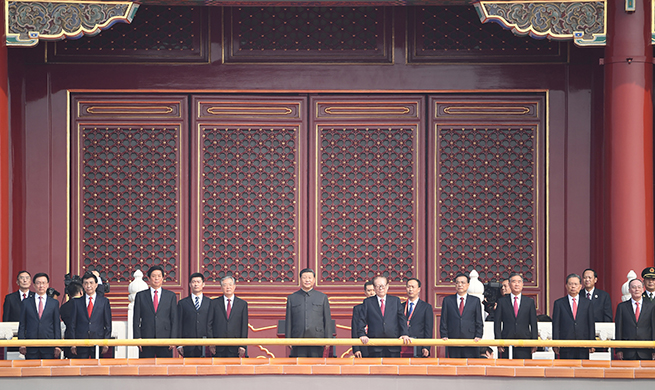WASHINGTON, Oct. 7 (Xinhua) -- A panel of forecasters expect U.S. real gross domestic product (GDP) growth to slow to 2.3 percent in 2019, and then to 1.8 percent in 2020, citing trade policy uncertainty as one of the downside risks, according to a survey newly released by the National Association for Business Economics (NABE).
"NABE Outlook Survey panelists believe the U.S. economy will continue to expand into 2020, but they anticipate GDP growth will fall below 2 percent next year for the first time since 2016," said NABE President Constance Hunter, chief economist at KPMG.
The survey, conducted from Sept. 9 to 16, presents the consensus macroeconomic forecast of a panel of 54 professional forecasters, the NABE said.
Survey chair Gregory Daco, chief U.S. economist at Oxford Economics, said the panel turned decidedly "more pessimistic" about the outlook over the summer, with 80 percent of participants viewing risks to the outlook as "tilted to the downside."
Four out of five panelists (81 percent) expressed the belief that risks to the economic outlook are weighted to the downside, an increase from the 60 percent who held this view in June, the new report showed. Respondents anticipated that GDP growth would register 1.8 percent in 2020, down from 2.1 percent forecasted in the June survey.
"The rise in protectionism, pervasive trade policy uncertainty, and slower global growth are considered key downside risks to U.S. economic activity," Daco said. The report noted that trade policy is perceived as the "dominant risk," with 53 percent of panelists citing it as the key downside risk to the economy through 2020.
The U.S. economy expanded by 2.9 percent in 2018. In the second quarter this year, U.S. GDP growth recorded 2 percent, a deceleration from the 3.1-percent growth in the first quarter.
Recent weak economic data have rattled financial markets and raised concerns over a U.S. recession, bolstering expectations for the U.S. Federal Reserve to cut rates again at its next policy meeting later this month.
According to data released by the Institute for Supply Management (ISM) last week, the purchasing managers' index (PMI), which gauges the performance of the manufacturing sector, fell to 47.8 percent in September, the second month of contraction in a row and the lowest since June 2009.
The non-manufacturing index (NMI), which gauges the performance of the services sector, meanwhile, registered 52.6 percent in September, the lowest reading since August 2016.
On Friday, the U.S. Bureau of Labor Statistics reported that U.S. employers added fewer-than-expected 136,000 jobs in September, down from August's revised number of 168,000. Despite a five-decade low unemployment rate of 3.5 percent in September, job growth has been slowing over the past few months, with an average monthly gain of 161,000 so far this year, below the 223,000 in 2018, the government's job report showed.













